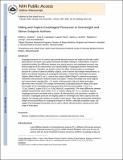| dc.contributor.author | Owens, Robert L. | en_US |
| dc.contributor.author | Campana, Lisa M. | en_US |
| dc.contributor.author | Hess, Lauren | en_US |
| dc.contributor.author | Eckert, Danny J. | en_US |
| dc.contributor.author | Loring, Stephen H. | en_US |
| dc.contributor.author | Malhotra, Atul | en_US |
| dc.date.accessioned | 2014-02-13T19:01:56Z | |
| dc.date.issued | 2012 | en_US |
| dc.identifier.citation | Owens, Robert L., Lisa M. Campana, Lauren Hess, Danny J. Eckert, Stephen H. Loring, and Atul Malhotra. 2012. “Sitting and Supine Esophageal Pressures in Overweight and Obese Subjects Authors.” Obesity (Silver Spring, Md.) 20 (12): 2354-2360. doi:10.1038/oby.2012.120. http://dx.doi.org/10.1038/oby.2012.120. | en |
| dc.identifier.issn | 1930-7381 | en |
| dc.identifier.uri | http://nrs.harvard.edu/urn-3:HUL.InstRepos:11708646 | |
| dc.description.abstract | Esophageal pressure can be used to approximate pleural pressure and might be clinically useful, particularly in the obese e.g to guide mechanical ventilator settings in critical illness. However, mediastinal artifact (the difference between true pleural pressure and esophageal pressure) may limit acceptance of the measurement, and reproducibility of esophageal pressure measurements remains unknown. Therefore, we aimed to assess the effect of body posture on esophageal pressure in a cohort of obese but healthy subjects, some of whom had multiple measurements, to address the clinical robustness of esophageal manometry. Twenty-five overweight and obese subjects (BMI>25kg/m2) and 11 control lean subjects (BMI<25kg/m2) underwent esophageal manometry with pressures measured seated and supine. Twenty overweight and obese subjects had measurements repeated after ~1-2 weeks. Anthropometric data and sitting and supine spirometry were recorded. The average end-expiratory esophageal pressures sitting and supine were greater in the overweight and obese group than the lean group (sitting −0.1±2.1 vs. −3.3±1.2cmH2O, supine 9.3±3.3 vs. 6.9±2.8cmH2O, respectively). The mean differences between repeated measurements were small (−0.3 ± 1.7cmH2O sitting and −0.1 ± 1.5cmH2O supine). Esophageal pressures correlated with a number of anthropometric and spirometric variables. In conclusion, esophageal pressures are slightly greater in overweight and obese subjects than lean subjects; but changes with position are similar in both groups. These data indicate that mediastinal weight and postural effects on esophageal pressure are within a clinically acceptable range, and suggest that esophageal manometry can be used to inform clinical decision making across wide range of body types. | en |
| dc.language.iso | en_US | en |
| dc.relation.isversionof | doi:10.1038/oby.2012.120 | en |
| dc.relation.hasversion | http://www.ncbi.nlm.nih.gov/pmc/articles/PMC3443522/pdf/ | en |
| dash.license | LAA | en_US |
| dc.subject | Obesity | en |
| dc.subject | mediastinal artifact | en |
| dc.subject | pleural pressure | en |
| dc.subject | transpulmonary pressure | en |
| dc.subject | lung | en |
| dc.title | Sitting and Supine Esophageal Pressures in Overweight and Obese Subjects Authors | en |
| dc.type | Journal Article | en_US |
| dc.description.version | Version of Record | en |
| dc.relation.journal | Obesity (Silver Spring, Md.) | en |
| dash.depositing.author | Eckert, Danny J. | en_US |
| dc.date.available | 2014-02-13T19:01:56Z | |
| dc.identifier.doi | 10.1038/oby.2012.120 | * |
| dash.contributor.affiliated | Eckert, Danny J. | |
| dash.contributor.affiliated | Loring, Stephen | |
| dash.contributor.affiliated | Malhotra, Atul | |


